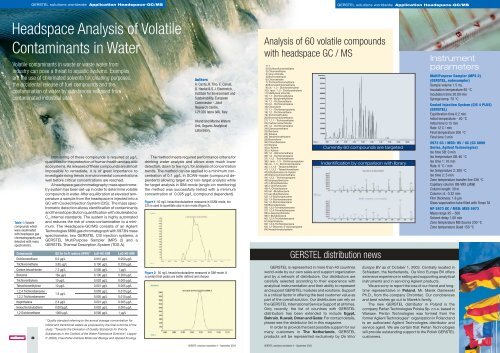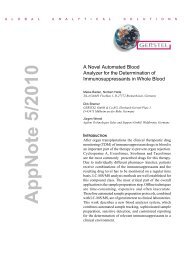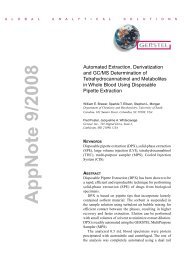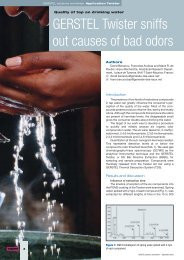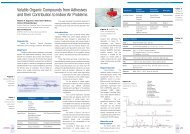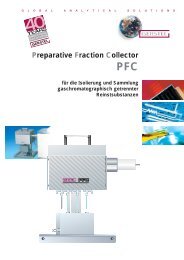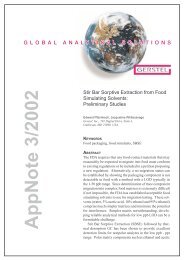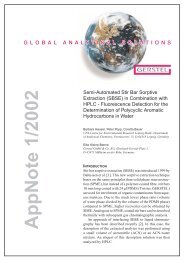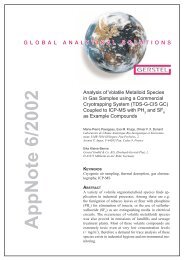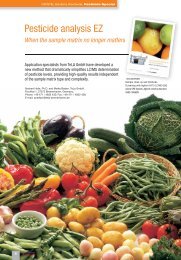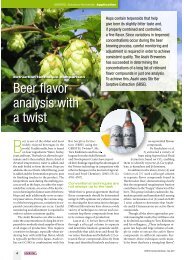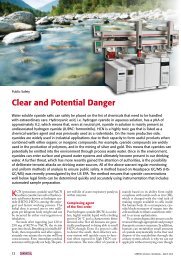GERSTEL Solution no 4
GERSTEL Solution no 4
GERSTEL Solution no 4
You also want an ePaper? Increase the reach of your titles
YUMPU automatically turns print PDFs into web optimized ePapers that Google loves.
<strong>GERSTEL</strong> solutions worldwide Application Headspace-GC/MS<br />
<strong>GERSTEL</strong> solutions worldwide Application Headspace-GC/MS<br />
Headspace Analysis of Volatile<br />
Contaminants in Water<br />
Volatile contaminants in waste or waste water from<br />
industry can pose a threat to aquatic systems. Examples<br />
are the use of chlorinated solvents for cleaning purposes,<br />
the accidental release of fuel compounds and the<br />
contamination of water by substances released from<br />
contaminated industrial sites.<br />
Table 1: Volatile<br />
compounds which<br />
were examinated<br />
with headspace gas<br />
chromatrography and<br />
detected with mass<br />
spectrometry.<br />
Monitoring of these compounds is required at µg/L<br />
quantities for the protection of human health and aquatic<br />
ecosystems. As releases of these compounds are almost<br />
impossible to remediate, it is of great importance to<br />
investigate rising trends in environmental concentrations<br />
well before critical concentrations are reached.<br />
A headspace gas chromatography mass spectrometry<br />
system has been set-up in order to determine volatile<br />
compounds in water. After equilibration at elevated temperature<br />
a sample from the headspace is injected into a<br />
GC with Cooled Injection System (CIS). The mass spectrometric<br />
detection allows identification of contaminants<br />
and the isotope dilution quantification with deuterated or<br />
C 13<br />
internal standards. The system is highly automated<br />
and reduces the risk of cross-contamination to a minimum.<br />
The Headspace-GC/MS consists of an Agilent<br />
Tech<strong>no</strong>logies 6890 gas chromatograph with 5973N mass<br />
spectrometer, two <strong>GERSTEL</strong> CIS injection systems, a<br />
<strong>GERSTEL</strong> MultiPurpose Sampler (MPS 2) and a<br />
<strong>GERSTEL</strong> Thermal Desorption System (TDS A).<br />
Authors<br />
A. Cantù, R. Tilio, E. Canuti,<br />
G. Hanke & S.J. Eisenreich,<br />
Institute for Environment and<br />
Sustainability, European<br />
Commission - Joint<br />
Research Centre,<br />
I-21020 Ispra (VA), Italy<br />
Inland and Marine Waters<br />
Unit, Organic Analytical<br />
Laboratory.<br />
The method meets required performance criteria for<br />
drinking water analysis and allows even much lower<br />
detection, down to few ng/L for analysis of concentration<br />
trends. The method can be applied to a minimum concentration<br />
of 0.1 µg/L in SCAN-mode (compound dependent)<br />
allowing target and <strong>no</strong>n-target analysis while<br />
for target analysis in SIM-mode (single ion monitoring)<br />
the method was successfully tested with a minimum<br />
concentration of 0.005 µg/L (compound dependent).<br />
Figure 1: 50 ng/L hexachlorobutadiene measured in SCAN-mode. Ion<br />
225 is used to quantitate also in sim mode (Figure 2).<br />
Analysis of 60 volatile compounds<br />
with headspace GC / MS<br />
1) ?<br />
2) Dichlorofluoromethane<br />
3) Chloromethane<br />
4) Vinyl chloride<br />
5) Bromomethane<br />
6) Chloroethane<br />
7) Trichlorofluoromethane<br />
8) Bromodichloromethane<br />
9) cis - 1,2 - Dichloroethylene<br />
10) t rans - 1,2 - Dichloroethylene<br />
11) Methylene chloride<br />
12) 1,1 - Dichloroethylene<br />
13) tert -Butylmethylether<br />
14) 1,1 - Dichloroethane<br />
15) 2,2 - Dichloropropane<br />
16) Chloroform<br />
17) 1,1 - Dichloropropylene<br />
18) 1,2 - Dichloroethane<br />
19) Trichloroethylene<br />
20) Bromochloromethane<br />
21) 1,1,1 - Trichloroethane<br />
22) Carbon tetrachloride<br />
23) 1,2 - Dichloropropane<br />
24) Dibromomethane<br />
25) Benzene<br />
26) Toluene<br />
28) Tetrachloroethylene<br />
29) Bromoform<br />
30) Chlorobenzene<br />
31) Styrene<br />
32) p-Xylene<br />
33) o-Xylene<br />
35) 1,2 - Dibromonethane<br />
36) 1,3 - Dichloropropane<br />
37) 1,1,2 - Trichloroethane<br />
38) t rans - 1,3 - Dichloropropylene<br />
39) cis - 1,3 - Dichloropropylene<br />
40) 1,1,1,2 - Tetrachlorethane<br />
41) 1,1,2,2 - Tetrachloroethane<br />
42) Ethylbenzene+m-Xylene<br />
43) Dibromochloromethane<br />
44) 1,2,3 - Trichloropropane<br />
46) Isopropylbenzene<br />
47) n-Propylbenzene<br />
48) 2-Chlorotoluene<br />
49) 4,-Chlorotoluene<br />
50) tert -Butylbenzene<br />
51) sec-Butylbenzene<br />
52) 1,3-Dichlorobenzene<br />
53) 1,4-Dichlorobenzene<br />
54) 1,2-Dichlorobenzene<br />
55) Bromobenzene<br />
56) 1,3,5-Trimethylbenzene<br />
57) 1,2,4-Trimethylbenzene<br />
58) p-Isopropyltoluene<br />
59) n-Butylbenzene<br />
60) 1,2,4-Trichlorobenzene<br />
61) Naphthalene<br />
62) 1,2,3-Trichlorobenzene<br />
63) 1,2-Dibromo-3-chloropropane<br />
64) Hexachlorobutadiene<br />
Currently 60 compounds are targeted<br />
Indentification by comparison with library<br />
<strong>GERSTEL</strong> distribution news<br />
Instrument<br />
parameters<br />
MultiPurpose Sampler (MPS 2)<br />
(<strong>GERSTEL</strong>, autosampler)<br />
Sample volume 1.5 mL<br />
Incubation temperature 60 °C<br />
Incubation time 20.00 min<br />
Syringe temp. 70 °C<br />
Cooled Injection System (CIS 4 PLUS)<br />
(<strong>GERSTEL</strong>)<br />
Equilibration time 0.2 min<br />
Initial temperature - 40 °C<br />
Initial time 0.15 min<br />
Rate 12 C / min<br />
Final temperature 200 °C<br />
Final time 3 min<br />
5973 GC / MSD: HS / GC (GC 6890<br />
Series, Agilent Tech<strong>no</strong>logies)<br />
Iso time SB: 0 min<br />
Iso temperature SB: 40 °C<br />
Iso time 1: 10 min<br />
Rate. 8 °C / min<br />
Iso temperature 2: 200 °C<br />
Iso time 2: 5 min<br />
Zone temperature transfer line 230 °C<br />
Capillary column: DB-VRX (J&W)<br />
Column length: 30 m<br />
Column i.d.: 0.32 mm<br />
Film thickness: 1.8 µm<br />
Glass vaporization tube filled with Tenax TA<br />
HP 5973 GC / MSD: MSD 5973<br />
Mass range 35 – 500<br />
Solvent delay 1.00 min<br />
Zone temperature MS Source 230 °C<br />
Zone temperature Quad 150 °C<br />
Compounds QS for In-Tr waters (WFD)* LoD-HS-SIM LoQ-HS-SIM<br />
Dichloromethane 8.2 µg/L 0.010 µg/L 0.050 µg/L<br />
Trichloromethane 3.85 µg/L 0.100 µg/L 0.250 µg/L<br />
<strong>GERSTEL</strong> is represented in more than 40 countries Europe BV as of October 1, 2003. Centrally located in<br />
Carbon tetrachloride 7.2 µg/L 0.500 µg/L 1 µg/L<br />
Figure 2: 50 ng/L hexachlorobutadiene measured in SIM-mode. It<br />
world-wide by our own sales and support organization Schiedam, the Netherlands, Da Vinci Europe BV offers<br />
Benzene 16a µg/L 0.100 µg/L 0.200 µg/L<br />
is evident that peaks are better defined and sharper.<br />
and by a network of distributors. Our distributors are extensive experience in selling and supporting analytical<br />
Trichloroethylene 10 µg/L 0.002 µg/L 0.005 µg/L<br />
carefully selected according to their experience with instruments and in servicing Agilent products.<br />
Tetrachloroethylene 10 µg/L 0.001 µg/L 0.005 µg/L<br />
analytical instrumentation and their ability to represent We are sorry to report the loss of our friend and longtime<br />
representative in Poland, Mr. Marek Daniewski<br />
1,2,4 Trichlorobenzene 0.005 µg/L 0.010 µg/L<br />
and support <strong>GERSTEL</strong> modules and solutions. Support<br />
1.8 µg/L<br />
1,2,3 Trichlorobenzene 0.005 µg/L 0.010 µg/L<br />
is a critical factor in offering the best customer value as Ph.D., from the company Chromtec. Our condolences<br />
part of the overall solution. Our distributors can rely on and best wishes go out to Marek’s family.<br />
Naphthalene 2.4 µg/L 0.001 µg/L 0.005 µg/L<br />
the <strong>GERSTEL</strong> International Service Support at all times. The new <strong>GERSTEL</strong> distributor in Poland is the<br />
Hexachlorobutadiene 0.003µg/L 0.002 µg/L 0.005 µg/L<br />
Only recently, the list of countries with <strong>GERSTEL</strong> company Perlan Tech<strong>no</strong>logies Polska Sp. z o.o. based in<br />
1,2 Dichloroethane 1060 µg/L 0.500 µg/L 1 µg/L<br />
distributors has been extended to include Egypt, Warsaw. Perlan Tech<strong>no</strong>logies was formed from the<br />
Bahrain, Kuwait, Oman and Qatar. For contact details, former Agilent Tech<strong>no</strong>logies“ organization in Poland and<br />
* Quality standard referring to the annual average concentration for<br />
please see the distributor list in this magazine.<br />
is an authorized Agilent Tech<strong>no</strong>logies distributor and<br />
inland and transitional waters as proposed by the final outcome of the<br />
In order to provide the best possible support for our service agent. We are certain that Perlan Tech<strong>no</strong>logies<br />
study: “Towards the Derivation of Quality Standards for Priority<br />
many customers in The Netherlands, <strong>GERSTEL</strong> will provide outstanding support to the Polish <strong>GERSTEL</strong><br />
Substances in the Context of the Water Framework Directive”, Lepper<br />
8 P. (2002), Fraunhofer-Institute Molecular Biology and Applied Ecology<br />
products will be represented exclusively by Da Vinci customers.<br />
9<br />
<strong>GERSTEL</strong> solutions worldwide 4 – September 2003<br />
<strong>GERSTEL</strong> solutions worldwide 4 – September 2003


